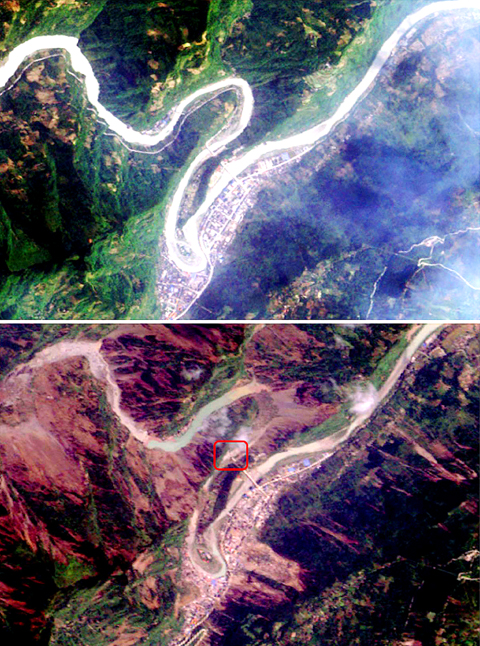The government yesterday reached an agreement with China to bring Taiwanese tourists home from earthquake-stricken Sichuan Province via direct charter flights.
“After bilateral coordination, China agreed to allow our planes to fly directly to Chongqing to bring our tourists back home,” Premier Chang Chun-hsiung (張俊雄) said yesterday afternoon.
The Travel Agent Association (TAA) said there were still 1,755 Taiwanese tourists in Sichuan Province and 1,143 in the Jiuzhaigou Valley at noon yesterday.

PHOTO: AFP
Owing to a lack of flights out of Sichuan’s Shuangliu International Airport in the wake of the devastating quake, only 173 Taiwanese were expected to be able to obtain seats on a plane to Hong Kong yesterday afternoon, the association said.
Twenty-six others are expected to get a flight home today, association officials said.
Mainland Affairs Council Chairman Chen Ming-tong (陳明通) told Chang that a deal on cross-strait charter flights for humanitarian purposes had been concluded at 3:30pm yesterday.
The arrangement was reached with the mediation of the TAA, the institution that had been commissioned by the government to negotiate with Beijing on routine charter flights in 2005.
The government initially wanted the flights to land at Shuangliu International Airport in Chengdu, the capital of Sichuan Province, near where the earthquake occurred, but decided to use Chongqing Jiangbei International Airport instead, as the Shuangliu airport was experiencing heavy traffic as relief efforts continued, Chen said.
Because of political differences, there are no direct air links between Taiwan and China, and people traveling across the Taiwan Strait are required to fly through a third area, usually Hong Kong or Macau.
Taiwan has been negotiating with China on routine cross-strait charter flights since 2005 to replace the ban on direct air flights that was implemented after the Chinese Nationalist Party (KMT) fled to Taiwan in 1949.
The first direct charter flight was implemented during the Lunar New Year holidays in 2005 to facilitate the transportation of Taiwanese businesspeople and their families.
Both sides of the Strait agreed in June 2006 to expand the scope of charter flights, including specialized cargo charter flights, the institutionalization of holiday passenger charter flights, charter flights for emergency medical treatment and special humanitarian charter flights for emergency relief and persons with disabilities or illness.
TAA chairman Yao Ta-kuang (姚大光) told a press conference later yesterday that TransAsia Airways (復興航空) would undertake the first flight to Chongqing this afternoon, which is to be followed by flights by China Airlines (華航) and EVA Air (長榮航空) this evening.
Taiwanese in Sichuan intending to make use of the flights should register with the TAA’s emergency command center in Chengdu, and the number to call is 0939-210-020, Yao said.
Meanwhile, two charter cargo planes provided by China Airlines, which flew directly to Chengdu, and Air Macau, which flew via Macau, landed in Sichuan later yesterday, carrying hundreds of tonnes of relief items donated by various charity groups in Taiwan.
Taipei Mayor Hau Lung-bin (郝龍斌) said that China had informed the Taiwanese branch of the Red Cross yesterday of its requirements for relief assistance.
The Taipei City Fire Department would team up with the Red Cross to send 20 relief workers to assist with rescue operations in the disaster zone this afternoon, Hau said.
Taiwan High Speed Rail Corp (台灣高鐵) executive director Ou Chin-der (歐晉德), who was previoulsy a board member of the Red Cross Society of the Republic of China, will lead the relief workers and a rescue dog to Chengdu today, Hau said.
Ou has extensive experience in leading relief work in Taipei City during the 921 earthquake in 1999.
Meanwhile, the Straits Exchange Foundation said that 22 Taiwanese who had either been traveling to or visiting Sichuan Province could not be reached yesterday.
Among them are 14 members of a tour group from Hsichou Township whose trip was organized by a travel agency in Changhua County.
Another eight people were either on backpack tours or visiting relatives.
The tour group has not been in contact with Taiwan since lunch time on Monday, approximately two hours before the magnitude-7.9 earthquake struck, Yao said at a news conference.
Yao said that the ashes of Taiwanese tourist Wang Min-chuan (王民權), who plunged to his death from a cable car in Dujiangyan during a rescue attempt by Chinese rescuers on Tuesday, would be returned home by his brothers today.
Wang, 56, plummeted to the ground on Tuesday as he was being rescued from a cable car that was stranded mid-air over Dujiangyan, Sichuan Province, after the earthquake struck on Monday, an official at the Straits Exchange Foundation said.
Wang was sent to a nearby hospital, where he died at 11:40pm on Tuesday.
Ten other people who had also been trapped in the 50m-high cable car system were brought to safety.
TAA figures show more than 3,000 Taiwanese tourists were in Sichuan when the earthquake struck.
About 1,000 of them have managed to return to Taiwan via Hong Kong over the past three days.
ADDITIONAL REPORTING BY MO YAN-CHIH AND CNA

The combined effect of the monsoon, the outer rim of Typhoon Fengshen and a low-pressure system is expected to bring significant rainfall this week to various parts of the nation, the Central Weather Administration (CWA) said. The heaviest rain is expected to occur today and tomorrow, with torrential rain expected in Keelung’s north coast, Yilan and the mountainous regions of Taipei and New Taipei City, the CWA said. Rivers could rise rapidly, and residents should stay away from riverbanks and avoid going to the mountains or engaging in water activities, it said. Scattered showers are expected today in central and

COOPERATION: Taiwan is aligning closely with US strategic objectives on various matters, including China’s rare earths restrictions, the Ministry of Foreign Affairs said Taiwan could deal with China’s tightened export controls on rare earth metals by turning to “urban mining,” a researcher said yesterday. Rare earth metals, which are used in semiconductors and other electronic components, could be recovered from industrial or electronic waste to reduce reliance on imports, National Cheng Kung University Department of Resources Engineering professor Lee Cheng-han (李政翰) said. Despite their name, rare earth elements are not actually rare — their abundance in the Earth’s crust is relatively high, but they are dispersed, making extraction and refining energy-intensive and environmentally damaging, he said, adding that many countries have opted to

FORCED LABOR: A US court listed three Taiwanese and nine firms based in Taiwan in its indictment, with eight of the companies registered at the same address Nine companies registered in Taiwan, as well as three Taiwanese, on Tuesday were named by the US Department of the Treasury’s Office of Foreign Assets Control (OFAC) as Specially Designated Nationals (SDNs) as a result of a US federal court indictment. The indictment unsealed at the federal court in Brooklyn, New York, said that Chen Zhi (陳志), a dual Cambodian-British national, is being indicted for fraud conspiracy, money laundering and overseeing Prince Holding Group’s forced-labor scam camps in Cambodia. At its peak, the company allegedly made US$30 million per day, court documents showed. The US government has seized Chen’s noncustodial wallet, which contains

SUPPLY CHAIN: Taiwan’s advantages in the drone industry include rapid production capacity that is independent of Chinese-made parts, the economic ministry said The Executive Yuan yesterday approved plans to invest NT$44.2 billion (US$1.44 billion) into domestic production of uncrewed aerial vehicles over the next six years, bringing Taiwan’s output value to more than NT$40 billion by 2030 and making the nation Asia’s democratic hub for the drone supply chain. The proposed budget has NT$33.8 billion in new allocations and NT$10.43 billion in existing funds, the Ministry of Economic Affairs said. Under the new development program, the public sector would purchase nearly 100,000 drones, of which 50,898 would be for civil and government use, while 48,750 would be for national defense, it said. The Ministry of